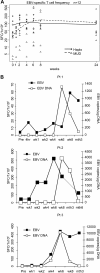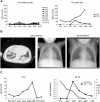Cytotoxic T lymphocyte therapy with donor T cells prevents and treats adenovirus and Epstein-Barr virus infections after haploidentical and matched unrelated stem cell transplantation
- PMID: 19700662
- PMCID: PMC2774556
- DOI: 10.1182/blood-2009-07-232454
Cytotoxic T lymphocyte therapy with donor T cells prevents and treats adenovirus and Epstein-Barr virus infections after haploidentical and matched unrelated stem cell transplantation
Abstract
Viral infection or reactivation remains a major cause of morbidity and mortality after allogeneic stem cell transplantation. We now show that infusions of single cytotoxic T lymphocyte (CTL) lines (5 x 10(6)-1.35 x 10(8) cells/m(2)) with specificity for 2 commonly detected viruses, Epstein-Barr virus (EBV) and adenovirus, can be safely administered to pediatric transplantation recipients receiving partially human leukocyte antigen-matched and haploidentical stem cell grafts (n = 13), without inducing graft-versus-host disease. The EBV-specific component of the CTLs expanded in vivo and persisted for more than 12 weeks, but the adenovirus-specific component only expanded in vivo in the presence of concomitant adenoviral infection. Nevertheless, adenovirus-specific T cells could be detected for at least 8 weeks in peripheral blood, even in CTL recipients without viral infection, provided the adenovirus-specific component of their circulating lymphocytes was first expanded by exposure to adenoviral antigens ex vivo. After infusion, none of these 13 high-risk recipients developed EBV-associated lymphoproliferative disease, while 2 of the subjects had resolution of their adenoviral disease. Hence, bispecific CTLs containing both EBV- and adenovirus-specific T cells can safely reconstitute an antigen responsive "memory" population of CTLs after human leukocyte antigen-mismatched stem cell transplantation and may provide antiviral activity. This trial was registered at www.clinicaltrials.gov as #NCT00590083.
Figures






References
-
- Chakrabarti S, Mautner V, Osman H, et al. Adenovirus infections following allogeneic stem cell transplantation: incidence and outcome in relation to graft manipulation, immunosuppression, and immune recovery. Blood. 2002;100(5):1619–1627. - PubMed
-
- Chakrabarti S, MacKinnon S, Chopra R, et al. High incidence of cytomegalovirus infection after nonmyeloablative stem cell transplantation: potential role of Campath-1H in delaying immune reconstitution. Blood. 2002;99(12):4357–4363. - PubMed
-
- Heslop HE, Ng CYC, Li C, et al. Long-term restoration of immunity against Epstein-Barr virus infection by adoptive transfer of gene-modified virus-specific T lymphocytes. Nat Med. 1996;2:551–555. - PubMed
-
- Walter EA, Greenberg PD, Gilbert MJ, et al. Reconstitution of cellular immunity against cytomegalovirus in recipients of allogeneic bone marrow by transfer of T-cell clones from the donor. N Engl J Med. 1995;333(16):1038–1044. - PubMed
Publication types
MeSH terms
Substances
Associated data
Grants and funding
LinkOut - more resources
Full Text Sources
Other Literature Sources
Medical

